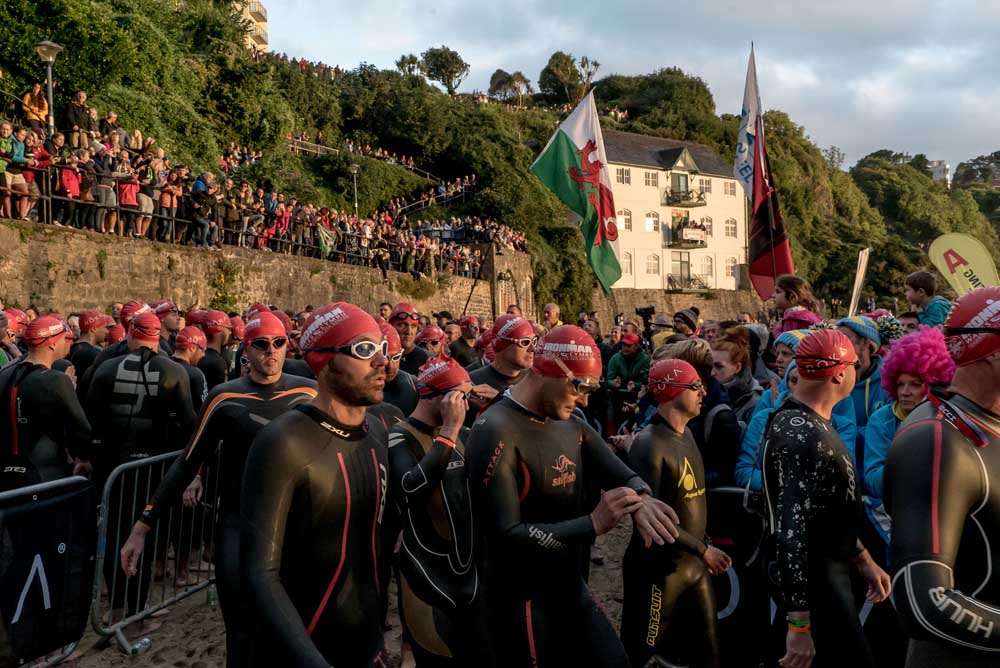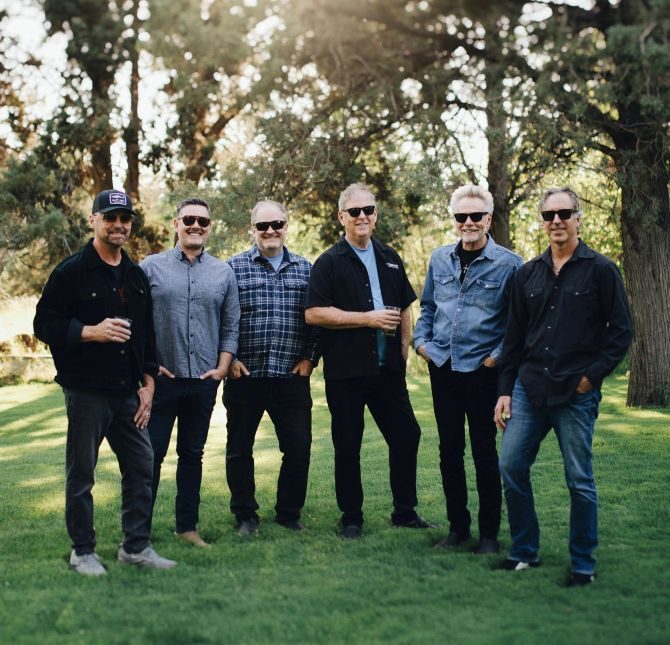A world triathlon capital, population 5,000
Published 12:00 am Monday, September 24, 2018

- **EMBARGO: No electronic distribution, Web posting or street sales before Monday 1:30 a.m. ET Sept. 24, 2018. No exceptions for any reasons. EMBARGO set by source.** Competitors line up before dawn on the beach in Tenby, Wales, before the start of the Wales Ironman, Sept. 9, 2018. The town has quickly become a favorite stop on the global Ironman circuit. But the race has also changed the local population, which now claims to have more triathletes per capita than anywhere else on Earth. (Andrew Testa/The New York Times)
TENBY, Wales — Ricky Hicks and Gary Evans scanned the list, searching for their names. Hicks spotted his first: No. 647. It took Evans a while longer. No surprise, really: Evans is a much more common surname in Wales. He had to pick through 27 to find his number. But still, it might have been worse: There were 55 athletes called Jones.
Hicks and Evans then walked toward the registration tent, where they would collect their race licenses and official numbers, and seal their fate. It was Friday, bright and warm. Evans was relaxed, confident. Hicks flickered with nervous energy, toying with a water bottle, shifting his weight from foot to foot, wondering if the weather would hold. Rain or shine, their Sunday was going to be hell.
It was all Evans’ fault. In 2017, Hicks had made the short journey to Tenby from his home in St. Clears — 10 minutes or so inland — to watch his friend compete in the Wales edition of the global Ironman series. He had seen Evans complete a 2.4-mile sea swim, a 112-mile cycle leg and a full 26.2-mile marathon in a little more than 12 hours.
What had struck Hicks, though, was the power of the crowd. Tens of thousands had thronged the streets of Tenby to watch the race. The noise, the fervor and the enthusiasm had captured his imagination. When he congratulated Evans on finishing, he told him he “would love to do something like that.”
Evans took him at his word. Without telling Hicks, he signed up again for this year’s contest, and he added his friend’s name, too. “I thought he may as well jump in at the deep end,” Evans said.
Hicks’ mood was not quite so buoyant as the race loomed, though. He had always been fit, playing rugby and soccer, and during the past year he had trained every day, running a marathon and a few half-distance events and going for a lot of long bike rides. He knew, though, that he had never done anything like this.
On Sunday, he would wake up at 2:30 a.m., have some toast and jam for breakfast, then make his way to the start line on Tenby’s North Beach just before 6 a.m. He had not set any ambitious targets; he would not be trying to beat Evans. Hicks’ aim was just to finish, to survive.
But still, he was nervous. “Dreading it,” in fact. At that, Evans smiled, wickedly, the smile of someone who knew what was coming.
It is that sort of place now, Tenby: a town where, sooner or later, there is a good chance you will end up doing an Ironman, whether you want to or not.
Crowds along the coast
Thirty-six hours before the race, good-luck messages have been scrawled into the sand of North Beach, a perfect swath of gold overlooked by pastel-colored houses. In the center of town, hundreds of competitors wander past the ice cream parlors and old-fashioned candy stores.
They are easily picked out: The vast majority carry an Ironman backpack, bright red, slung over a shoulder. Those who have completed a race often have a tattoo to showcase that fact: There are Ironman logos, a dotted capital M, drawn on arms and shoulders and countless calves, part badge of honor, part watermark. The visitors dawdle over coffee in the early-September sunshine, gaze out at the waters of Carmarthen Bay and earnestly compare training injuries and equipment reviews.
The Ironman arrived here, in this quiet seaside resort on the Pembrokeshire coast, in 2011. There was, at first, a degree of skepticism. The scale of the event is considerable. The swim takes place in the bay, before competitors race back on land and transfer onto bikes. The cycle route takes them north, to Narbeth, and then west, all the way to the village of Angle and back. When they return, the marathon course loops around Tenby four times.
Not everyone was thrilled to see the race arrive. Tenby is a tourist haven, and its population of 5,000 swells tenfold in the summer months. Some here were content with the business it had traditionally attracted.
The town, though, has taken the event to its heart. “It is a bit of a pain for the locals,” said Mike Neil, 42, who had come from the Rhondda Valley — in the heart of Wales’ old mining country — to compete. “All the roads for miles have to be closed for the day, but they really embrace it.”
Tenby is a young Ironman. The event started in Hawaii in 1978, and by the time Wales was awarded its race, 26 others were scattered around the globe. Next year, there will be 42 full Ironman events worldwide, each of them offering the chance to qualify for the world championships in Hawaii.
The Tenby race already has a reputation. “This is one of the hardest on the calendar,” said Mirka Vahtera, who had traveled from Finland with her brother, Mikko Tepponen, to take part. Most say that the event on Lanzarote, one of the Canary Islands — “where you run up a volcano,” according to Vahtera — is the toughest there is, but the rolling hills of the cycle section, the crosswinds and the unpredictable sea make Pembrokeshire a close second.
“But the support is the best,” Vahtera said. “There are always questionnaires on the Ironman website, asking people which event they have enjoyed the most, where the best atmosphere was. Everyone says Tenby.”
In part, of course, that popularity can be traced to the event’s economic effect: Tenby’s town council estimates that this year’s event, for example, brought 3.5 million pounds, or $4.6 million, into the local economy over race weekend.
What makes Tenby truly remarkable, though, is not just how much the locals want to support it, but how many want to take part. The town is fond of claiming that thanks to Ironman, it now has more triathletes per capita than anywhere else in the world.
“We think we have the largest percentage of local participation,” Andrew Davies, the town clerk, said. “It is certainly not six degrees of separation: Most people would know four or five people who have done it at least once.”
Davies is not one of them. “I would still be doing the swimming now,” he said, a couple of days after the 17-hour time limit to complete the course had elapsed. But then this is Tenby: Iron Town. It is probably better to say that Davies is not one of them yet.
A race saves a town
The story of Britain’s seaside resorts, over the past half-century, is one of inexorable decline.
The statistics, across much of the country, are grim reading. Blackpool, on the Irish Sea, now has the highest rate of deaths from heroin and morphine in Britain; five more coastal towns are in the top 10.
In 2013, a government study decreed Skegness, a resort on the North Sea coast, the most deprived in England. It was followed by Blackpool, Clacton, Hastings and Ramsgate: all resorts left behind by the rise of cheap air travel and a waning fishing industry.
Clacton, in Essex, is the only place in Britain to have had a member of Parliament from the far-right United Kingdom Independence Party. When that party’s on-again, off-again leader, Nigel Farage, mounted his most recent failed campaign to be elected, he stood in the coastal town Thanet, in Kent, another place ranked among the most deprived in the country.
Tenby, though, avoided the worst of it, its popularity sustained by the beauty of this part of Wales: all hidden coves, sheer cliffs and golden sand. Barafundle Bay, 30 minutes down the coast, is regularly voted one of the world’s best beaches, up there with Ipanema and Varadero. It remains a peaceful, neat sort of a place, attracting families, bus trips filled with retirees and increasingly — as Mark Sansum, 38, a regular visitor from Swansea, the nearest big city, put it — “stags and hens.”
Those bachelor and bachelorette parties, though, were not entirely welcome. The town center was made a “controlled drinking zone” in 2014. The police have been running a campaign to crack down on unruly behavior for several years, in part because of the lewdness and crudeness of the memorabilia being taken onto trains by groups celebrating one last night of freedom.
As the Ironman race has grown in popularity, that identity has started to shift.
“We still get a lot of families,” Davies, the town clerk, said. “But we see more and more people coming for fitness tourism.” Sansum, who visited regularly to train for his second attempt at the Ironman, was more blunt: The event, he said, “saved the town.”
It is not just race weekend that brings people here. While he was training, Hicks — the 23-year-old embarking, a little unwittingly, on his first Ironman — said the “roads were full of people all the time.” Martin Jones, 54, said there were hundreds of cyclists, swimmers and runners when he came for his final training session.
Gareth Rees, a founder of the Tenby Aces cycling and triathlon club, said his group had mushroomed to some 170 members since the launch of the Ironman, many of them drawn from all over Britain. “People come to train and want to ride or run or swim with us,” he said.
That effect has been noted across the region. “This event has been a huge catalyst for the popularity of multisport events,” said Peter Munn, a member of the Pembrokeshire cycling club, based in Haverfordwest, the area’s largest town. His group has doubled in size in recent years, to 175 members: The youngest is 8 and the oldest 77.
Tenby, meanwhile, has become a different sort of place. It holds another multisport event during the year, as well as several smaller competitions. Iron Kids, a juniors event that runs on Ironman weekend, welcomed 1,000 entrants in 2017. That total doubled this year, such was the demand. Davies said the council had noted an increase in the number of people using its leisure facilities in recent years, and he said there had been a concomitant decrease in demands placed on its health services.
The impact, though, may be broader still. In Swansea, Sansum said, there are “four or five” triathlon clubs within a few miles’ drive. In the Valleys, meanwhile, Wales’ industrial heartland, the sport is booming.
“You hear stories of five lads from the same village of just a few houses who are here to do it,” said Ben Jones, who had come with Neil Williams from Rhondda to compete.
Williams added: “There is a real fascination with it. It is a challenge. A chance to see what you’re made of.”








